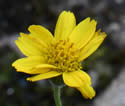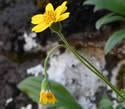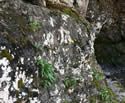Arnica lonchophylla (Long-leaf Arnica)
| Also known as: | Northern Arnica |
|---|---|
| Genus: | Arnica |
| Family: | Asteraceae (Aster) |
| Life cycle: | perennial |
| Origin: | native |
| Status: |
|
| Habitat: | part shade, shade; average moisture; cliffs |
| Bloom season: | June - July |
| Plant height: | 6 to 20 inches |
| Wetland Indicator Status: | none |
| MN county distribution (click map to enlarge): |  |
| National distribution (click map to enlarge): |  |
Pick an image for a larger view. See the glossary for icon descriptions.
Detailed Information
Flower: 

![[photo of flower]](/udata/r9ndp23q/jt/arnica-lonchophylla-7-t.jpg) Flowers are single or in a cluster of 2 to 8 flowers that is more or less flat across the top (in profile), the stalks often all attached at the very tip of the stem, though a few stalks may be branched. Flowers are 1 to 2 inches across, daisy-like with a yellow center disk and 6 to 10 (usually 8) yellow rays (petals).
Flowers are single or in a cluster of 2 to 8 flowers that is more or less flat across the top (in profile), the stalks often all attached at the very tip of the stem, though a few stalks may be branched. Flowers are 1 to 2 inches across, daisy-like with a yellow center disk and 6 to 10 (usually 8) yellow rays (petals).
![[photo of phyllaries]](/udata/r9ndp23q/jt/arnica-lonchophylla-5-t.jpg) Cupping the flower head are 6 to 14 narrow, green floral bracts (phyllaries) covered in spreading hairs. Flower stalks are long and slender, also covered in spreading hairs, and may have a pair of small leaf-like bracts about midway up the stalk.
Cupping the flower head are 6 to 14 narrow, green floral bracts (phyllaries) covered in spreading hairs. Flower stalks are long and slender, also covered in spreading hairs, and may have a pair of small leaf-like bracts about midway up the stalk.
Leaves and stems: 


![[photo of basal leaves, with old persistent leaves]](/udata/r9ndp23q/jt/arnica-lonchophylla-3-t.jpg) Leaves are basal and opposite, narrowly lance to egg-shaped, rounded to tapering at the base, tapering to a pointed tip. Both upper and lower surfaces are variably covered in a mix of glandular and non-glandular hairs, though may be hairless or nearly so. Basal and the lowest stem leaves are up to 6 inches long and 1½ inches wide with a few teeth around the edge, 3 prominent veins, and have long, slender stalks. Old, withered basal leaves often persist to the next season.
Leaves are basal and opposite, narrowly lance to egg-shaped, rounded to tapering at the base, tapering to a pointed tip. Both upper and lower surfaces are variably covered in a mix of glandular and non-glandular hairs, though may be hairless or nearly so. Basal and the lowest stem leaves are up to 6 inches long and 1½ inches wide with a few teeth around the edge, 3 prominent veins, and have long, slender stalks. Old, withered basal leaves often persist to the next season.
![[photo of upper stem and leaves]](/udata/r9ndp23q/jt/arnica-lonchophylla-10-t.jpg) Stem leaves are few, opposite, widely spaced, quickly become much smaller than the basal leaves, stalkless and toothless or nearly so. Stems are unbranched except in the flower cluster, single or a few from the base, and covered in short, spreading hairs. Plants spread vegetatively from scaly rhizomes, and non-flowering colonies are not unusual.
Stem leaves are few, opposite, widely spaced, quickly become much smaller than the basal leaves, stalkless and toothless or nearly so. Stems are unbranched except in the flower cluster, single or a few from the base, and covered in short, spreading hairs. Plants spread vegetatively from scaly rhizomes, and non-flowering colonies are not unusual.
Fruit: 
![[photo of developing fruit]](/udata/r9ndp23q/jt/arnica-lonchophylla-4-t.jpg) Fruit is a dry seed with a tuft of white hair (pappus) to carry it off in the wind.
Fruit is a dry seed with a tuft of white hair (pappus) to carry it off in the wind.
Notes:
Long-leaf Arnica is a very rare, subarctic species, preferring cool, shady, north or west-facing cliffs that are neither too wet nor too dry. According to the DNR, it was first collected in 1932 from the cliffs of Clearwater Lake in Cook County, near the Canadian border. There are currently only 6 known sites, most of which are near the north shore of Lake Superior, some of which were first discovered in the 1930s and 1940s and were found to be still surviving in recent years in what are now state parks. It was listed as a state Threatened species in 1984.
Long-leaf Arnica resembles Ragwort (Packera) species, but has opposite stem leaves where Ragworts are alternate, and are also usually distinctly lobed. Some references note two subspecies of A. lonchophylla, but these are not recognized in Minnesota; if they were, our populations would be subsp. lonchophylla, with subsp. arnoglossa restricted to Wyoming, South Dakota, and parts of Canada. Documentation on these subspecies is lacking, to say the least. Arnica has a long history of herbal uses, including treating pain, bleeding, diarrhea and digestive conditions. I once tried it on muscle pain on the advice of a personal trainer I know—the only effect was removing a few dollars from my wallet.
Native Plant Nurseries, Restoration and Landscaping Services ↓
More photos
 Long-leaf Arnica plant
Long-leaf Arnica plant Long-leaf Arnica plants
Long-leaf Arnica plants Long-leaf Arnica habitat
Long-leaf Arnica habitat Long-leaf Arnica habitat
Long-leaf Arnica habitat flower cluster branching
flower cluster branching
Photos by John Thayer taken in Lake County.
Comments
Have you seen this plant in Minnesota, or have any other comments about it?






